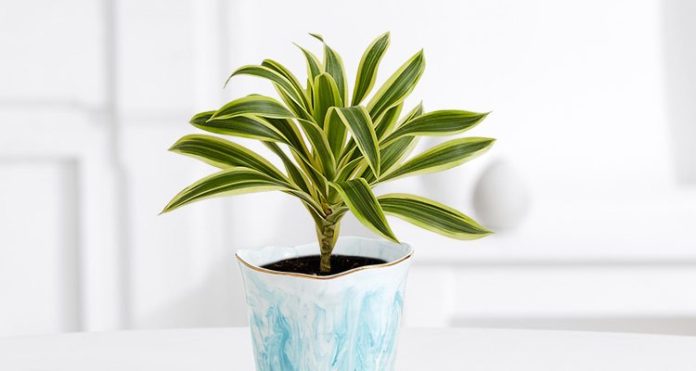All Dracaena plant types are a beautiful complement to a variety of settings. Dracaena plant species give some of the most significant possibilities in houseplants when it comes to style and time.
Dracaena marginata,fragrans,Warnecke, and deremensis are some of the most common types. They are distinctive, whimsical shapes and luxuriant foliage. They also come in various sizes, so you can use them to dress up a whole blank wall or only refresh the edge of a coffee table.
We’ve highlighted 12 of our most delicate indoor Dracaena Plants, along with professional care instructions and important considerations, so you can find your ideal match. You’ll also learn everything there is to know about the Dracaena plant types including their advantages, meanings, and symbols. Enjoy!
Dracaena Facts
The Greek term for female dragon is the source of the name Dracaena. Because of this, dracaena plants and trees are commonly referred to as dragon plants or trees.
Corn plants, cornstalk dracaena, cane plats, mass cane plants, ribbon plants, and ribbon plants are various names for different types of Dracaena.
Did you know that several dracaena species aids in air purification? For example, Dracaena deremensis, Dracaena marginata, ‘ Warneckei,’ and Dracaena massangeana (mass cane or maize cane plant) help eliminate certain pollutants from the air, according to a NASA research. Xylene, formaldehyde, and toluene are just a few harmful substances that dracaena plants can clear up.
Dracaena species are among the most shade-tolerant of all the houseplants you can cultivate indoors. They’re also drought-tolerant, so you can virtually ignore them, and they’ll still flourish.
Read More- What Are Some Good Creepers Plants Example?
Uses and Benefits
Enhance Air Quality
Green plants help restore oxygen levels in the atmosphere, and some can cleanse it. Dracaena plants are among the best plants for improving indoor air quality. According to NASA’s clean air research, Dracaena plants can eliminate formaldehyde, trichloroethylene, toluene, carbon dioxide, xylene & benzene from your indoor environment.
Use as a decoration
Dracaena plants are popular as decorative plants. They come in various startling forms and sizes, and their evergreen foliage is so stunning that they may be used in almost any design scheme. For example, use a taller variety to fill in an empty space, a fuller cultivar to balance furniture, and tiny dracaenas as table or desk decorations.
Varnishes and Dyes
The sap of several dracaena cultivars is a distinctive crimson tint. The crimson sap has been used as a varnish and dye for generations. In fact, it’s claimed to be the source of Stradivarius violins’ red hue.
Read More- How To Grow String Of Dolphins Plant?
Different Dracaena Plant Types:
Below we will discuss some popular varieties of Dracaena plants.
Dracaena Draco
It’s a succulent tree typically kept as a pot plant. Still, you can plant it outside if you reside in a tropical or subtropical climate. It’ll develop into a broad, thickly branched tree that can reach 25 feet tall.
One very ancient species was 70 feet tall. Draco’s sword-like, bluish-green blades will grow around 2′ feet long if left to succeed in this manner.
The tree produces tiny, greenish-white blooms in the summer, which turn into orange berries in the fall.
Dracaena Fragans
The corn plant is another name for this one. It features glossy, comprehensive, and lancing dark green leaves with thick foliage. It has thick, green stalks that resemble canes.
It prefers to be in the shade, although it can also handle some indirect light. It also has a growth habit similar to that of palms, which is why it is sometimes known as fake palms. In containers, it may reach a height of 6 feet.
Gold Dust
Try Gold Dust for a smaller, shrubbier dracaena. Green leaves with golden speckles become white over time. The red margined Dracaena, popularly known as Madagascar Dragon Tree, has slender leaves with red-purple borders. Red and white stripes can be found on some cultivars, such as ‘Tricolor.’
The ribbon plant is a tiny dracaena that grows 4 to 5 inches (10-13 cm) tall. The leaves have white edges and are lance-shaped. There are a few varieties of the dracaena species Deremensis.
‘Janet Craig’ is a popular variety with glossy, dark green foliage.
‘Lemon Lime’ is a newer variety with green, emerald, and white striped leaves.
The leaves of ‘Warneckii’ are leathery and green with white streaks. These cultivars are from the reflexa family known as “Song of India” or “Jamaica.” The thin leaves of ‘Song of India’ have cream or white borders, but the deeper green leaves of ‘Song of Jamaica’ have light green cores.
There are so many various varieties of dracaenas to choose from, and they’re so simple to grow that there’s no reason to not have one in every room of the home.
Marginata
This kind is commonly referred to as D. marginata and is a popular houseplant species native to Madagascar. Madagascar are intriguing Dracaena plant types just like their name.
However, botanists now recognize D. reflexa var. Angustifolia is the terminology for this, indicating that it is a naturalized variant of the reflexa species, not a new species.
For simplicity, we’re going to give you a break and classify it as its own species. This is how the plant is referred to on most plant tags, stores, and horticulture sites.
The most intriguing aspect of this species is how it matures into a thin, serpentine shape with a bare stem and a spray of multicolored foliage at the top.
It’s also known as the Madagascar dragons tree or red edge dracaena. The tree can grow up to ten feet tall, but it takes a long time.
Each leaf is colorful, with a combination of red, emerald, and yellow stripes along its length. The leaves of the ‘Bicolor’ cultivar are green and white with a hint of red, while the leaves of the ‘Tricolor’ cultivar have a considerably more noticeable red border.
This kind is straightforward to care for, so it’s no surprise that it’s one of the most popular.
Dracaena Arborea
Another Dracaena is Dracaena arborea,
This variety is an actual tree suitable for the outdoors, as the name implies. It thrives in a semi-desert environment in the wild.
With its strong trunk, single or many heads, and broad, stiff leaves, Tree Dracaena may be the plant for you if you live in a hot, dry climate and need tall, palm-like trees for your backyard.
Tree Dracaena thrives in various conditions, from part shade to intense sunshine. Despite their drought tolerance, you’ll get more significant results if you water them regularly and use well-draining soil.
Read More- 31 Best Plants For Rock Garden
Sanderiana
Another common Dracaena plant types are Sanderiana, a unique dracaena species, is also known as lucky bamboo. It’s rarely seen in its natural state since it’s sort of ugly in that state. It has a few dispersed leaves per bush with no apparent order or organization, and it seems a little out of place even when it’s at its healthiest. However, if it’s been nurtured, trimmed, and managed for interior display, it’ll draw your attention.
It’s not often that you come across a plant that appears to be so stripped-down and bare. I give it a lot of additional points for that. D. sanderiana may be grown in water (as it is commonly sold under the name “lucky bamboo”) or in soil, just like any other houseplant.
Dracaena Warneckii
Dracaena warneckii is also known as Striped Dracaena or Dracaena Warnock.
Because it’s a tiny tree or shrub, this Dracaena deremensis variation looks like
Janet Craig.
The leaves, on the other hand, are different. They’re pointed, slender, and have unique white stripes longitudinally along the middle.
Dracaena Lemon Lime is a fascinating Dracaena deremensis cultivar.
It has chartreuse leaves with white stripes and gray-green cores in an intriguing shade of chartreuse.
Trifasciata
You’re probably more acquainted with them as snake plants or mother-in-tongue, the laws. Still, they’ve recently been categorized as part of the Dracaena genus.
These feature thick, robust, erect leaves that can grow many inches from their containers, with no trunk or stems, in contrast to the majority of the plants on this list. On the other hand, the foliage is still tall and spiky, patterned, and green. On a small table or in a container on the floor, dark green or light, and shadow green stripes, occasionally with an extra yellow or bluish-green stripe for comparison purposes, make an attractive addition to home décor.
They simply need to be watered once in a while, and you can very much leave them alone to do their job.
Hawaiian Sunshine Dracaena
These Dracanea plant types look a lot like Lisa. It’s a new cultivar produced from Hilo girl, another dracaena. It’s commonly mistaken for corn, but this one has larger leaves with a distinguishing bright green stripe going across the middle. In containers, it may reach a height of 4 feet.
Read More- Learn More about Calcium Deficiency in Plants
To Sum Up
If you’re thinking about getting a dracaena plant, there are a few things you should know about its maintenance requirements:
• Water: They don’t need to be watered regularly. In fact, misting is even more helpful than watering. When they are overwatered, they are vulnerable to decay. Once a week, spray your plants.
• Light: Dracaena plants do best in filtered light or partial to full shade. Long exposures of direct solid sunlight burn the leaves of this plant.
• Temperature: This plant prefers a temperature range of 80 degrees Fahrenheit throughout the day and 55 degrees Fahrenheit at night. It also flourishes in the humidified environment of a standard room.
• Fertiliser: Ordinary dracaena plants do not require fertilizer to thrive. Fertilizing new varieties and hybrids during their early months of development may be beneficial.
Which Dracaena plant types do you believe are the most inexpensive and widely available?
Please let us know in the comments below.
Read More- What’s Damaging My Outdoor Plants? 5 Common Issues

















